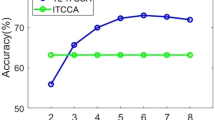Abstract
Steady-state visual evoked potential (SSVEP)-based brain computer-interface (BCI) is one of the most popular BCI systems. An efficient SSVEP-based BCI system in shorter time with higher accuracy in recognizing SSVEP has been pursued by many studies. This paper introduces a novel multiway canonical correlation analysis (Multiway CCA) approach to recognize SSVEP. This approach is based on tensor CCA and focuses on multiway data arrays. Multiple CCAs are used to find appropriate reference signals for SSVEP recognition from different data arrays. SSVEP is then recognized by implementing multiple linear regression (MLR) between EEG and optimized reference signals. The proposed Multiway CCA is verified by comparing to the standard CCA and power spectral density analysis (PSDA). Results showed that the Multiway CCA achieved higher recognition accuracy within shorter time than that of the CCA and PSDA.
Access this chapter
Tax calculation will be finalised at checkout
Purchases are for personal use only
Preview
Unable to display preview. Download preview PDF.
Similar content being viewed by others
References
Müller-Putz, G.R., Scherer, R., Brauneis, C., Pfurtscheller, G.: Steady-state visual evoked potential (SSVEP)-based communication: impact of harmonic frequency components. J. Neural Eng. 2, 123–130 (2005)
Zhu, D., Bieger, J., Molina, G., Aarts R.M.: A survey of stimulation methods used in SSVEP-based BCIs. Comput. Intell. Neurosci. (2010), doi: 10.1155/2010/702357
Zhang, Y., Jin, J., Qing, X., Wang, B., Wang, X.: LASSO based stimulus frequency recognition model for SSVEP BCIs. Biomed. Signal Process. Control (2011), doi:10.1016/j.bspc.2011.02.002
Cheng, M., Gao, X., Gao, S., Xu, D.: Design and implementation of a brain-computer interdace with high transfer rates. IEEE Trans. Biomed. Eng. 49, 1181–1186 (2002)
Lin, Z., Zhang, C., Wu, W., Gao, X.: Frequency recognition based on canonical correlation analysis for SSVEP-based BCIs. IEEE Trans. Biomed. Eng. 53, 2610–2614 (2006)
Hakvoort, G., Reuderink, B., Obbink, M.: Comparison of PSDA and CCA detection methods in a SSVEP-based BCI-system. Technical Report TR-CTIT-11-03. EEMCS (2011), ISSN 1381-3625
Kim, T.K., Cipolla, R.: Canonical correlation analysis of video volume tensor for action categorization and detection. IEEE Trans. PAMI 31, 1415–1428 (2009)
Hotelling, H.: Relations between two sets of variates. Biometrika 28, 321–377 (1936)
Cichocki, A., Zdunek, R., Phan, A., Amari, S.: Nonnegative matrix and tensor factorizations: Applications to exploratory multi-way data analysis and blind source separation. Wiley, New York (2009)
Wolpaw, J.R., Birbaumer, N., McFarland, D.J., Pfurtscheller, G., Vaughan, T.M.: Brain-computer interface for communication and control. Clin. Neurophysiol. 113, 767–791 (2002)
Chatterjee, S., Hadi, A.S.: Influential observations, high leverage points, and outliers in linear regression. Statistical Science 1, 379–416 (1986)
Author information
Authors and Affiliations
Editor information
Editors and Affiliations
Rights and permissions
Copyright information
© 2011 Springer-Verlag Berlin Heidelberg
About this paper
Cite this paper
Zhang, Y. et al. (2011). Multiway Canonical Correlation Analysis for Frequency Components Recognition in SSVEP-Based BCIs. In: Lu, BL., Zhang, L., Kwok, J. (eds) Neural Information Processing. ICONIP 2011. Lecture Notes in Computer Science, vol 7062. Springer, Berlin, Heidelberg. https://doi.org/10.1007/978-3-642-24955-6_35
Download citation
DOI: https://doi.org/10.1007/978-3-642-24955-6_35
Publisher Name: Springer, Berlin, Heidelberg
Print ISBN: 978-3-642-24954-9
Online ISBN: 978-3-642-24955-6
eBook Packages: Computer ScienceComputer Science (R0)




